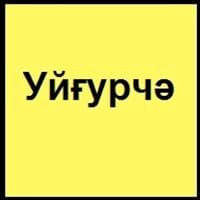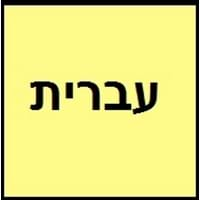National Language
China
Israel
Second Language
Not spoken in any of the countries
Israel
Speaking Continents
Asia
Africa, Asia, Europe
Minority Language
Kazakhstan, Uzbekistan
Poland
Regulated By
Working Committee of Ethnic Language and Writing of Xinjiang Uyghur Autonomous Region
Academy of the Hebrew Language
Interesting Facts
- Uyghur language has large quantity of loan words from Persian, Russian and Chinese.
- Uyghur was originally written with the Orkhon Alphabets.
- The original language of Bible is Hebrew.
- The men and women use different verbs in hebrew language.
Similar To
Uzbek Language
Arabic and Aramaic languages
Derived From
Gokturk Language
Aramaic Language
Alphabets in
Uyghur-Alphabets.jpg#200
Hebrew-Alphabets.jpg#200
Scripts
Arabic, Cyrillic, Latin
Hebrew
Writing Direction
Left-To-Right, Vertical, Top-To-Bottom
Right-To-Left, Horizontal
Hello
Ässalamu läykum.
שלום (Shalom)
Thank You
rakhmat
תודה (Toda)
How Are You?
Yakshimasiz? / Qandaq ahwalingiz?
מה שלומך? (ma shlomxa)
Good Night
Kachlikingz khayrilik bolsun
לילה טוב (Laila tov)
Good Evening
Kachlikingz khayrilik bolsun!
ערב טוב (Erev tov)
Good Afternoon
Not Available
אחר צהריים טובים (Achar tzahara'im tovim)
Good Morning
Atiganlikingz khayrilik bolsun!
בוקר טוב (Boker tov)
Please
birdam
בבקשה (bevekshah)
Sorry
kachurung
סליחה! (Slicha)
Bye
Khayr khosh
להתראות (Lehitraot)
I Love You
sizni yahshi kOrman
אני אוהבת אותך (Ani ohevet otcha)
Excuse Me
Kachurung
בבקשה!
Dialect 1
Turpan
Ashkenazi Hebrew
Where They Speak
China
Israel
Dialect 2
Hotan
Samaritan Hebrew
Where They Speak
China
Israel, Palestine
Dialect 3
Lop Nur
Yemenite Hebrew
Where They Speak
China
Israel
Speaking Population
Not Available
Second Language Speakers
Not Available
Native Name
Уйғур /ئۇيغۇر (ujġgur / uyghur)
עברית / עִבְרִית (ivrit)
Alternative Names
Uighuir, Uighur, Uiguir, Uigur, Uygur, Weiwu’er, Wiga
Israeli, Ivrit
French Name
ouïgour
hébreu
German Name
Uigurisch
Hebräisch
Pronunciation
[ʊjʁʊrˈtʃɛ], [ʊjˈʁʊr tili]
[(ʔ)ivˈʁit] - [(ʔ)ivˈɾit]
Ethnicity
Uyghur
Not Available
Language Family
Turkic Family
Afro-Asiatic Family
Subgroup
Not Available
Semitic
Branch
Not Available
Canaanitic
Early Forms
Karakhanid, Chagatai, Eastern Turki
Biblical Hebrew, Mishnaic Hebrew, Medieval Hebrew, Hebrew
Standard Forms
Uyghur
Modern Hebrew
Signed Forms
Not Available
Signed Hebrew
Scope
Not Available
Individual
ISO 639 6
Not Available
Not Available
Glottocode
uigh1240
hebr1246
Linguasphere
No data Available
12-AAB-a
Language Type
Not Available
Living
Language Linguistic Typology
Not Available
Subject-Verb-Object, Verb-Subject-Object
Language Morphological Typology
Not Available
Fusional, Synthetic
All Uyghur and Hebrew Dialects
Most languages have dialects where each dialect differ from other dialect with respect to grammar and vocabulary. Here you will get to know all Uyghur and Hebrew dialects. Various dialects of Uyghur and Hebrew language differ in their pronunciations and words. Dialects of Uyghur are spoken in different Uyghur Speaking Countries whereas Hebrew Dialects are spoken in different Hebrew speaking countries. Also the number of people speaking Uyghur vs Hebrew Dialects varies from few thousands to many millions. Some of the Uyghur dialects include: Turpan, Hotan. Hebrew dialects include: Ashkenazi Hebrew , Samaritan Hebrew. Also learn about dialects in South American Languages and North American Languages.
Uyghur and Hebrew Speaking population
Uyghur and Hebrew speaking population is one of the factors based on which Uyghur and Hebrew languages can be compared. The total count of Uyghur and Hebrew Speaking population in percentage is also given. The percentage of people speaking Uyghur language is 0.12 % whereas the percentage of people speaking Hebrew language is Not Available. When we compare the speaking population of any two languages we get to know which of two languages is more popular. Find more details about how many people speak Uyghur and Hebrew on Uyghur vs Hebrew where you will get native speakers, speaking population in percentage and native names.
Uyghur and Hebrew Language Codes
Uyghur and Hebrew language codes are used in those applications where using language names are tedious. Uyghur and Hebrew Language Codes include all the international language codes, glottocodes and linguasphere.





